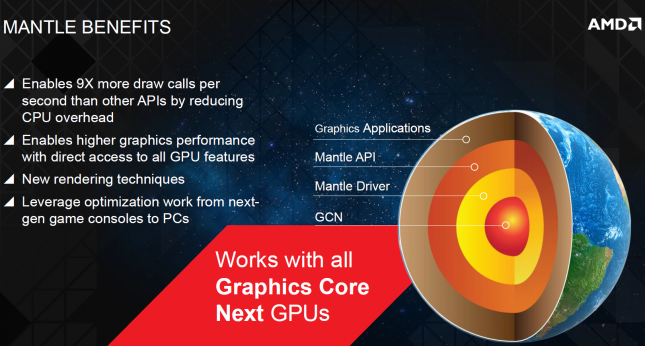Is AMD Mantle Dead As We Have Known It? Vulcan API Uses Mantle Technology for OpenGL
AMD no longer has plans to release a public Mantle SDK, but that doesnt mean the Mantle API is dead. In fact, AMD says that they are working on something more important than a public Mantle SDK is on its way. That is intriguing as in the first year of being released the Mantle API gained support from five advanced game engines and 10 premium applications that has led to a number of AAA game titles that have supported Mantle. Game titles such as Battlefield Hardline, Dragon Age: Inquisition, Plants vs. Zombies Garden Warfare, Sid Meiers’s Civilization: Beyond Earth, Battlefield 4, Thief, Star Citizen and Sniper Elite III all feature the Mantle API.
Raja Koduri, VP of Visual and Perceptual Computing at AMD, said in a blog post published yesterday that AMD is a company that fundamentally believes in technologies unfettered by restrictive contracts, licensing fees, vendor lock-ins or other arbitrary hurdles to solving the big challenges in graphics and computing.
With that he noted that AMD will be releasing a 450-page programming guide and API reference for Mantle will be available this month on the AMD Mantle website.
Raja also noted that we as gamers are approaching era of DirectX 12 and the Next-Generation OpenGL Initiative also known as GLnext. AMD said that they will show not only the future of Mantle, but the future of PC graphics itself this year at the Game Developer Conference 2015.
It looks like the first major announcement was made this morning when the Khronos Group announced that they will be using parts of the Mantle API to serve as the foundation for Vulkan, the next version of the OpenGL API. OpenGL is widely used on MacOS, Linux and Windows, so getting some of the Mantle code into the Vulkan API is seen as a big win for PC Gamers and those wanting to see improvements in cross-platform gaming. The comment on the blog that is caused people to think Mantle was dead makes more sense now.
“If you are a developer interested in Mantle “1.0” functionality, we suggest that you focus your attention on DirectX 12 or GLnext.”
From the sounds of it AMD is no longer telling developers to use the original Mantle API and to focus their attention on DirectX 12 of the Vulkan API released by The Kronos Group today. AMD has always said that they wanted to keep Mantle open and flexible and it appears that they are staying true to that commitment. AMD says that Mantle is not dead, but even if Mantle did die today, but it looks like its time alone in the spot light being the only low level API is finally over. Some of the key code from the API will live on, but will AMD Mantle still be around?
AMD just this afternoon published more information in a new blog post about on Vulkan and Mantle with hopes of clearing this up. Here is a snip of that blog post by Robert Hallock, Head of Global Technical Marketing at AMD.
What does Mantle do now? AMD has cryptically repliedwith very good reasonthat Mantles destiny is openness and coexistence. Today were ready to be clear on one aspect of what that means.
The cross-vendor Khronos Group has chosen the best and brightest parts of Mantle to serve as the foundation for Vulkan, the exciting next version of the storied OpenGL API.
WHAT THIS MEANS
OpenGL has long and deservedly commanded respect for being a fast, versatile and wide open API that works on all graphics vendors across multiple operating systems.
Meanwhile, Mantle has seen acclaim for many improvements in gaming and game development: higher framerates, reduced rendering latency, reduced GPU power consumption, better use of multi-core CPUs, and re-pioneering new features like split-frame rendering.
Vulkan combines and extensively iterates on these characteristics as one new and uniquely powerful graphics API. And as the product of an incredible collaboration between many industry hardware and software vendors, Vulkan paves the way for a renaissance in cross-platform and cross-vendor PC games with exceptional performance, image quality and features.
Crystal clear now right?


